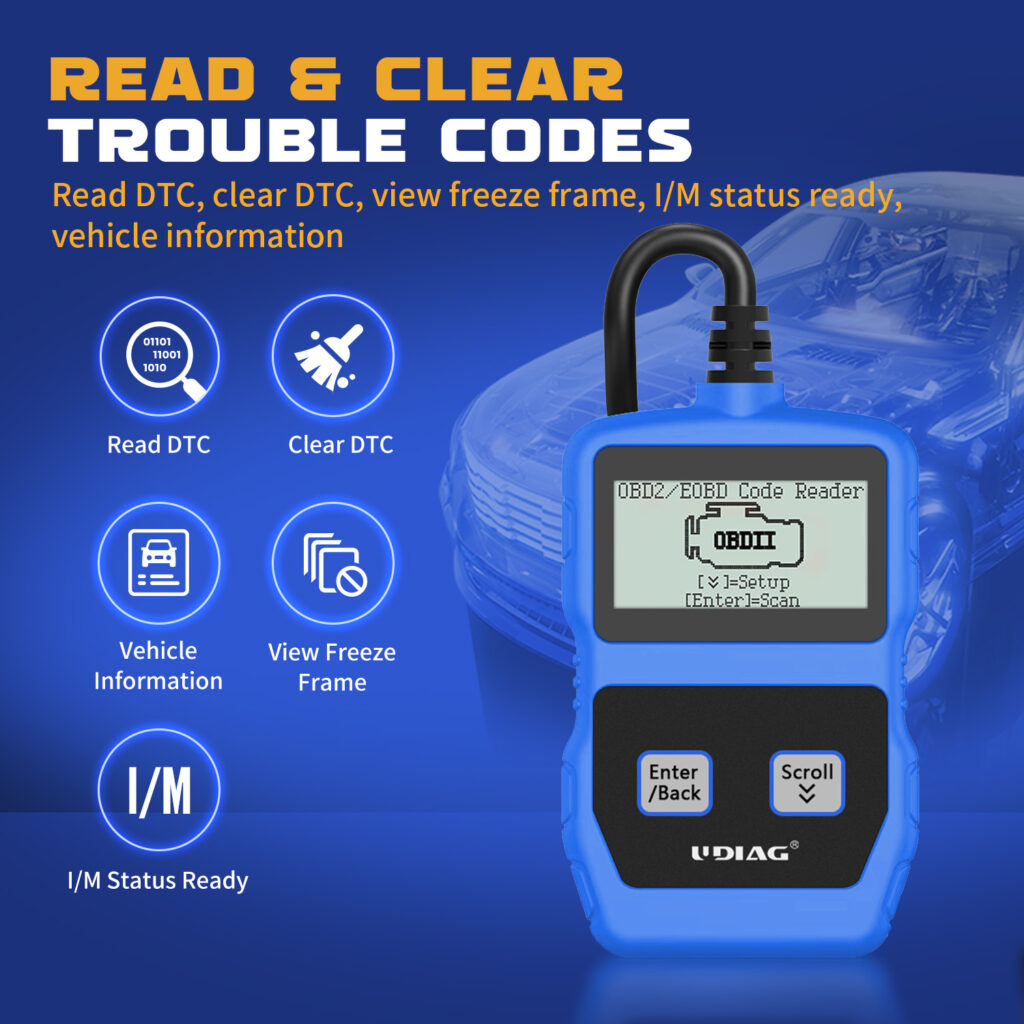What are common OBD2 trouble codes and their meanings?
2024-04-28 by UDIAG
In the intricate network of modern vehicles, On-Board Diagnostics II (OBD2) stands as a guardian, monitoring the health of various systems and alerting us when something goes awry. Understanding OBD2 trouble codes is akin to deciphering the language of your car’s internal health report. This essay delves into the realm of OBD2 trouble codes, exploring their significance and shedding light on some common codes encountered by motorists.

I. How OBD2 Trouble Codes Work
OBD2, the second generation of On-Board Diagnostics, is a standardized system implemented in vehicles to monitor and regulate engine performance and emissions. Central to this system are trouble codes, which are alphanumeric identifiers generated by the vehicle’s onboard computer when it detects abnormalities in various systems. These codes serve as clues, guiding technicians and motorists towards diagnosing and resolving underlying issues.
II. Common OBD2 Trouble Codes
1. Engine System Codes:
- P0300 – Random/Multiple Cylinder Misfire Detected: Indicates potential issues with engine misfires, which can stem from faulty spark plugs, ignition coils, or fuel delivery problems.
- P0171/P0174 – System Too Lean (Bank 1/Bank 2): Points towards a lean fuel-to-air mixture in the engine, often caused by vacuum leaks, faulty oxygen sensors, or clogged fuel injectors.
- P0420/P0430 – Catalyst System Efficiency Below Threshold (Bank 1/Bank 2): Alerts to potential inefficiencies in catalytic converters, typically caused by aging components or engine misfires.
2. Transmission System Codes:
- P0700 – Transmission Control System Malfunction: Indicates issues within the transmission control system, necessitating further diagnosis to pinpoint the exact problem.
- P0715/P0720 – Input/Turbine Speed Sensor Circuit Malfunction/Output Speed Sensor Circuit Malfunction: Indicates potential issues with speed sensors, crucial for proper transmission operation.
3. Emission Control System Codes:
- P0440/P0442/P0455 – Evaporative Emission Control System Malfunction/Leak Detected (Small Leak)/Leak Detected (Large Leak): Alert to problems within the vehicle’s evaporative emission control system, often related to fuel vapor leaks or malfunctioning components.
III. Interpretation of OBD2 Trouble Codes
Understanding OBD2 trouble codes involves decoding the alphanumeric strings generated by the vehicle’s onboard computer. A code reader or scan tool is essential for retrieving these codes, which can then be cross-referenced with code definitions to identify the underlying issues. Proper interpretation of codes is crucial for effective diagnosis and repair.
IV. Troubleshooting and Fixing OBD2 Trouble Codes
Upon retrieving OBD2 trouble codes, the next step involves systematic troubleshooting to identify and address the root cause of the problem. Diagnostic steps may include visual inspections, component testing, and data analysis using specialized tools. Addressing underlying issues promptly not only resolves current problems but also prevents potential damage to other vehicle systems.
Conclusion
In the intricate ecosystem of modern automobiles, OBD2 trouble codes serve as invaluable diagnostic tools, offering insights into the health and performance of various vehicle systems. By understanding common OBD2 trouble codes and their meanings, motorists can navigate the complexities of vehicle maintenance and repair with confidence. Regular monitoring of OBD2 codes, coupled with timely diagnosis and repair, ensures smooth and efficient operation of vehicles while minimizing the risk of costly breakdowns. Embracing the language of OBD2 trouble codes empowers motorists to take proactive measures in safeguarding their vehicles’ health and longevity.
Get Access Now: https://www.udiagtech.com
FAQs
1. What is OBD2, and why are trouble codes important?
OBD2, or On-Board Diagnostics II, is a standardized system in vehicles that monitors and regulates engine performance and emissions. Trouble codes are alphanumeric identifiers generated by the vehicle’s onboard computer when it detects abnormalities in various systems. They are important because they provide insights into potential issues with the vehicle, guiding technicians and motorists towards diagnosis and repair.
2. How do I retrieve OBD2 trouble codes from my vehicle?
OBD2 trouble codes can be retrieved using a code reader or scan tool, which plugs into the vehicle’s OBD2 port. Once connected, the tool communicates with the vehicle’s onboard computer to retrieve stored trouble codes.
3. What do the letters and numbers in OBD2 trouble codes mean?
The letters in OBD2 trouble codes indicate the system or subsystem affected by the issue (e.g., “P” for powertrain, “C” for chassis, “B” for body, and “U” for network or communication). The numbers following the letter(s) provide specific information about the nature of the problem.
4. Are OBD2 trouble codes the same for all vehicles?
While many OBD2 trouble codes are standardized across all vehicles, some manufacturers may also use their own proprietary codes in addition to the generic ones. This means that some codes may be specific to certain makes and models of vehicles.
5. What should I do if my vehicle’s check engine light comes on?
If the check engine light (or malfunction indicator lamp) illuminates, it indicates that the vehicle’s onboard computer has detected a problem. The first step is to retrieve the trouble codes using a code reader or scan tool. Once the codes are retrieved, they can be used to diagnose the underlying issue and determine the appropriate course of action.
6. Can I clear OBD2 trouble codes myself?
Yes, OBD2 trouble codes can typically be cleared using a code reader or scan tool. However, it’s important to address the underlying issue causing the codes to be triggered before clearing them. Simply clearing the codes without diagnosing and fixing the problem may result in the issue persisting or recurring.


